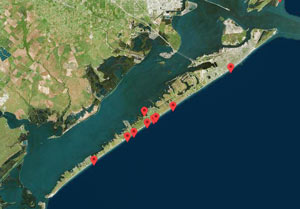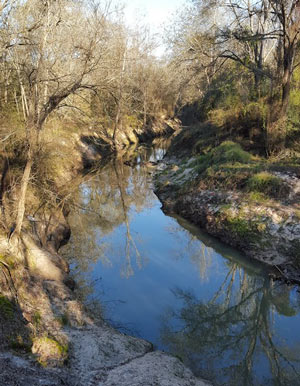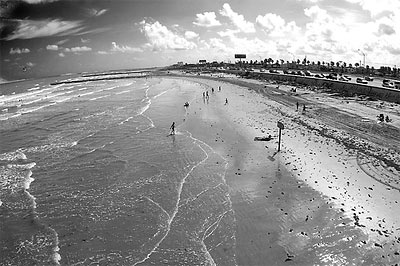EXCESSIVE GALVESTON BEACH BACTERIA PROBABLY NOT LEG-THREATENING, JUST FECAL, SAY OFFICIALS  Scott Packard assures KHOU this week that the beach advisories put out by the Galveston County Health District lately aren’t related to flesh-eating strains of Vibrio bacteria — the agency has been fielding concerned phone calls in the wake of a Jacinto City man’s ongoing hospitalization and forced amputation due to a suspected Vibrio infection following a swim in Galveston with an open wound. But direct infection from seawater contact, while a perennial occurrence in Gulf Coast states, is nonetheless extraordinarily rare, Packard says. Rather, the beach advisories reflect above-standard measuremens of run-of-the-mill fecal bacteria: “Typically after periods of heavy rains [in] any recreational or coastal area, rain water will wash cattle waste, pet waste and some sewage overflows into the Gulf through rivers and streams, and that will make the levels spike for typically a day or so.” [KHOU; previously on Swamplot] Galveston Island sites with high bacteria levels: Texas General Land Office
Scott Packard assures KHOU this week that the beach advisories put out by the Galveston County Health District lately aren’t related to flesh-eating strains of Vibrio bacteria — the agency has been fielding concerned phone calls in the wake of a Jacinto City man’s ongoing hospitalization and forced amputation due to a suspected Vibrio infection following a swim in Galveston with an open wound. But direct infection from seawater contact, while a perennial occurrence in Gulf Coast states, is nonetheless extraordinarily rare, Packard says. Rather, the beach advisories reflect above-standard measuremens of run-of-the-mill fecal bacteria: “Typically after periods of heavy rains [in] any recreational or coastal area, rain water will wash cattle waste, pet waste and some sewage overflows into the Gulf through rivers and streams, and that will make the levels spike for typically a day or so.” [KHOU; previously on Swamplot] Galveston Island sites with high bacteria levels: Texas General Land Office
Tag: Bacteria
GROUP FORMS TO CLEAN UP THE UPPER SAN JACINTO BEFORE IT GETS AS BAD AS BRAYS, BUFFALO, SIMS BAYOUS  The West Fork of the San Jacinto River (implicated in much of the latest flooding between The Woodlands and Conroe) is in a bacterial “sweet spot”, environmental planner Justin Bower tells Matthew Tresaugue in the Houston Chronicle this week  — more contaminated than is acceptable, Bower says, “but not so much that we can’t do anything about it.” Tresaugue writes that E. coli levels have been trending upward since 2002, in some cases running as high as 10,000 colonies per 100 milliters of water (around 80 times higher than the 126-colony limit recommended by the state of Texas). The river’s water quality problems are multifaceted, but generally boil down to increased development in the watershed causing increased runoff that carries more junk — from human and animals waste to sediment from a nearby gravel mining operation — into the river and ultimately the Lake Houston reservoir (from which the city pulls drinking water). The newly formed West Fork Watershed Partnership has no definite plan yet (other than to work with area stakeholders to develop a plan). But Lisa Gonzalez (VP of the Houston Area Research Council) notes to Tresaugue that not doing anything could allow the West Fork’s water problems to get as bad as those of other major urban waterways in Houston. [Houston Chronicle; previously on Swamplot] Photo of West Fork of the San Jacinto: West Fork Watershed Partnership
The West Fork of the San Jacinto River (implicated in much of the latest flooding between The Woodlands and Conroe) is in a bacterial “sweet spot”, environmental planner Justin Bower tells Matthew Tresaugue in the Houston Chronicle this week  — more contaminated than is acceptable, Bower says, “but not so much that we can’t do anything about it.” Tresaugue writes that E. coli levels have been trending upward since 2002, in some cases running as high as 10,000 colonies per 100 milliters of water (around 80 times higher than the 126-colony limit recommended by the state of Texas). The river’s water quality problems are multifaceted, but generally boil down to increased development in the watershed causing increased runoff that carries more junk — from human and animals waste to sediment from a nearby gravel mining operation — into the river and ultimately the Lake Houston reservoir (from which the city pulls drinking water). The newly formed West Fork Watershed Partnership has no definite plan yet (other than to work with area stakeholders to develop a plan). But Lisa Gonzalez (VP of the Houston Area Research Council) notes to Tresaugue that not doing anything could allow the West Fork’s water problems to get as bad as those of other major urban waterways in Houston. [Houston Chronicle; previously on Swamplot] Photo of West Fork of the San Jacinto: West Fork Watershed Partnership

Phew! It’s okay to get back in the water at Galveston beaches. Those high levels of Enterococcus bacteria reported on Wednesday, indicating high levels of fecal matter, are gone. Everything’s back to normal!
Where does all that shit come from, anyway? Sewage treatment plants, septic tanks, boating waste, and storm water runoff, among other sources. Says the Texas General Land Office:
Water contact should be avoided for 48 hours following periods of heavy, prolonged rainfall.
Thanks for the tip, guys! You can track bacteria levels daily with a handy interactive map tool at the Texas General Land Office’s Beach Watch website. (Their happy slogan: “Check the Net Before You Get Wet!”) Other bacteria to watch out for: various species of Vibrio, which cause a few deaths a year. But don’t worry—you won’t need to check the net for Vibrio levels, because they aren’t monitored at all.
- Beachgoers return as bacteria levels recede [Houston Chronicle]
- Eeeewwwww! [Houstonist]
- The Texas Beach Watch Program [General Land Office]
Photo: flickr user rodlkennedy

